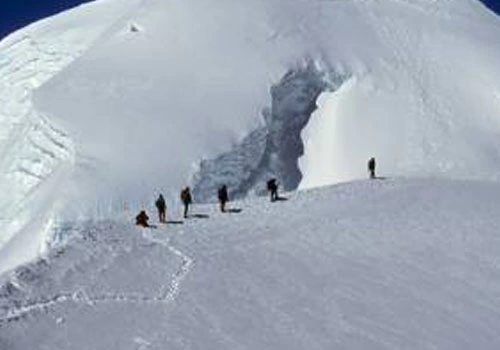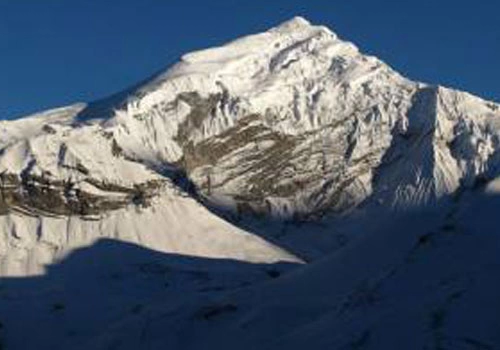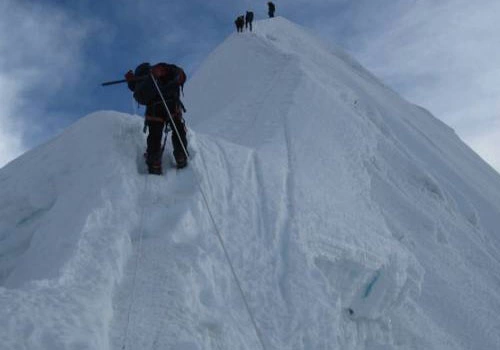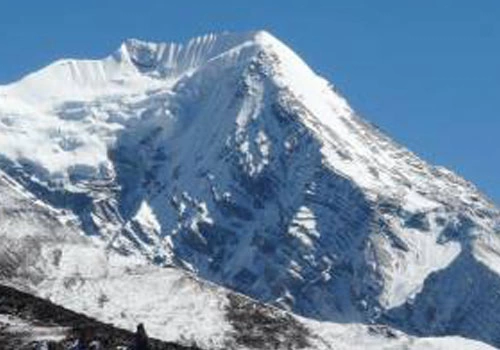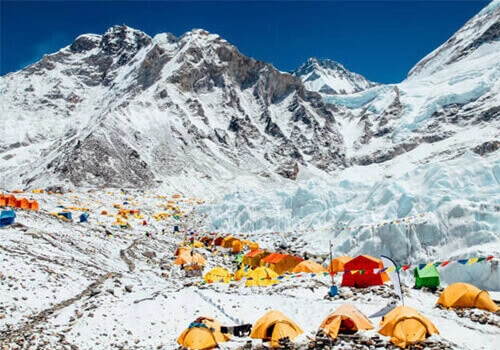Peak Climbing in Nepal, Mountain Climb Cost 2025 and 2026
Best Time for Peak Climbing in Nepal
Peak Climbing in Nepal is one of the most exhilarating adventures for mountaineers and thrill-seekers around the world. The country is blessed with over 1,300 peaks above 6,000 meters, and many of them are designated as “trekking peaks,” making them accessible to climbers with moderate experience. The two standout seasons for peak climbing spring and autumn offer ideal conditions that combine breathtaking scenery with technical challenges suited to both novice and seasoned climbers.
Springtime envelops the Himalayas in vibrant hues, with rhododendron forests in full bloom and clear skies that frame majestic summits like Island Peak and Mera Peak. Climbers benefit from longer days and warmer temperatures, making this season highly popular for expeditions. On the other hand, autumn presents crisp air, unparalleled visibility, and dry conditions that are perfect for safe ascents. During this time, climbers often find the trails more stable and the cultural backdrop enriched by local festivals like Dashain and Tihar an added charm to the adventure.
Whether you’re conquering the icy slopes of Lobuche East, navigating the rugged beauty of Pisang Peak, or simply soaking in panoramic views from a high-altitude base camp, Peak Climbing in Nepal offers an unforgettable blend of nature, challenge, and cultural immersion. It’s more than just reaching the summit; it’s about embracing a journey into the heart of the Himalayas, where every ascent becomes a story of resilience and awe.
Do’s and Don’ts for Peak Climbing in Nepal
Do’s
- Build your strength, endurance, and altitude tolerance through cardio and resistance workouts.
- Take rest days and ascend gradually to avoid altitude sickness.
- High-altitude climbing demands constant energy and hydration.
- Dress modestly, and follow customs in villages and monasteries.
- Mountain weather changes fast plan accordingly.
- Keep permits, insurance, and ID handy at all times.
- Pack out all waste and respect the fragile mountain environment.
Don’ts
- Don’t rush the climb it increases the risk of altitude sickness and injury.
- Don’t ignore symptoms like dizziness or nausea they’re your body’s warning signs.
- Overpacking weighs you down so stick to the essentials.
- Avoid disturbing sacred sites or wildlife.
- Solo climbing increases risk without help, even minor issues can escalate quickly in remote regions.
- Don’t gamble without insurance, evacuation and emergencies can be very costly.
Accommodation in Peak Climbing in Nepal
Accommodation during Peak Climbing in Nepal varies widely depending on the phase of the journey and altitude, but it’s all part of the unique Himalayan experience. Before the climb begins, travelers typically stay in well-equipped hotels or guesthouses in cities like Kathmandu or Pokhara, where they can enjoy hot showers, internet access, and other modern comforts while preparing for their ascent. As climbers move along trekking routes toward base camps, they stay in teahouses modest mountain lodges offering basic rooms, simple meals like dal bhat and noodles, and often solar-powered electricity. These teahouses provide a warm and welcoming atmosphere and are operated by local families, allowing climbers to immerse themselves in the rich culture of Nepal’s mountain communities. At higher altitudes, especially during the summit approach, accommodation shifts to tented camps set up by expedition teams. These camps include sleeping tents, dining areas, and support from Sherpa guides and cooks who prepare nutritious meals to maintain climbers’ strength and morale. While facilities become more rugged and amenities sparse, the intimacy with nature and focus on teamwork heighten the sense of adventure. For those who prefer an extra layer of comfort, luxury lodges are available in certain lower trekking areas, offering upgraded amenities like ensuite bathrooms, gourmet meals, and even spa services. From city hotels to snowy camps, accommodation during Peak Climbing in Nepal not only supports the journey but also enriches it, creating moments of rest, connection, and reflection in some of the most awe-inspiring environments on Earth.
Meals and Drinks in Peak Climbing in Nepal
Meals and drinks during Peak Climbing in Nepal are crafted to meet the high-energy demands of climbers while offering comfort and cultural flavor. In the lower regions along popular trekking routes, teahouses serve a mix of traditional Nepali dishes and simple international meals. A staple food is dal bhat a hearty combination of rice, lentils, and vegetables often complemented by chapati, noodle soups, and pancakes. These meals are not only satisfying but designed to help maintain stamina during long trekking days. As climbers ascend to higher altitudes, food choices become more basic due to limited access to fresh ingredients. Meals focus on carbohydrate-rich options such as potatoes, pasta, and rice to provide lasting energy and aid acclimatization.
Drinks are equally essential, both for warmth and hydration. Popular choices include ginger tea and garlic soup, both believed to help with altitude sickness and digestion. Masala chiya (spiced milk tea) is widely enjoyed, adding a comforting touch, while butter tea a salty, high-calorie beverage is common in alpine areas. Staying properly hydrated is critical, and climbers must rely on boiled or purified water to avoid health risks. Overall, meals and drinks during Peak Climbing in Nepal not only nourish the body but also enrich the climbing experience with warmth, tradition, and local hospitality.
Peak Climbing in Nepal Cost and Price
At Welcome Nepal Treks we offer tailored Peak Climbing in Nepal packages that fit your goals, comfort level, and budget. Prices depend on the chosen peak, length of the expedition, climbing season, and support services included. Our standard packages cover climbing permits, domestic transportation, guides, porters, meals, accommodation, and camping gear. We also manage logistics like crew insurance and environmental fees for a worry-free experience. Whether you're a first-time climber or a seasoned adventurer, we provide both cost-effective options and luxury upgrades from shared teahouses to premium lodges and personalized gear assistance.
Guide/Porter on Peak Climbing in Nepal
During Peak Climbing in Nepal, guides and porters play an essential role in ensuring safety, success, and an enriching experience. A licensed guide is not just a route leader they’re your mountain mentor, cultural interpreter, and first responder. They help with navigation, monitor your health for altitude-related issues, and offer insights into local customs and traditions. Most guides are trained professionals, often from mountain communities, with deep knowledge of terrain, weather patterns, and climbing techniques. Porters, on the other hand, are the unsung heroes who carry the bulk of expedition gear, allowing climbers to conserve energy for the ascent. Their strength and endurance are vital, especially in high-altitude regions where every step becomes more demanding.
Porters typically transport tents, food supplies, climbing equipment, and personal belongings, ensuring everything arrives safely at each stop. Beyond logistics, these local experts bring warmth, resilience, and stories that transform a climb into a cultural journey. Whether you're a seasoned mountaineer or a first-time climber, having a reliable guide and porter team is key to making Peak Climbing in Nepal both safe and unforgettable.
Packing List for Peak Climbing in Nepal
Packing for Peak Climbing in Nepal requires thoughtful preparation to ensure safety, comfort, and efficiency across varying altitudes and weather conditions. A well-organized packing list typically includes the following:
- Layered base, mid, and outer wear for varying temperatures
- Insulated jacket & waterproof shell
- Thermal pants, gloves, socks, and beanie
- Sturdy mountaineering boots (crampon-compatible)
- Sunglasses & gaiters
- High-altitude sleeping bag & pad
- Water purification tools
- Energy bars, nuts, dried fruits
- Reusable bottle & hydration salts
- Toiletries, sunscreen, wet wipes
- Headlamp, trekking poles, daypack
- Documents (ID, permits, insurance)
- First-aid kit
- Altitude sickness meds
- Power Bank
How to prepare for Peak Climbing in Nepal?
Preparing for Peak Climbing in Nepal is a thrilling challenge that demands physical stamina, mental resilience, and smart planning. Whether you're aiming for beginner-friendly summits or more technical climbs, here’s a comprehensive guide to get you ready:
- Build fitness over several months focusing on cardio, strength, and flexibility
- Practice visualization, stay positive, and develop perseverance for difficult conditions
- Learn how to use crampons, harnesses, and ice axes; understand crevasse rescue and glacier navigation
- Acquire high-quality equipment and layered clothing suitable for extreme mountain climates
- Schedule proper rest days to safely adjust to high altitudes and avoid altitude sickness
- Approach the adventure with humility, caution, and appreciation for nature’s power
Permits & Legal Requirements for Peak Climbing in Nepal
- Passport copy with valid visa
- Travel insurance that covers emergency helicopter rescue and high-altitude treatment
- A health certificate, especially for climbs to higher elevations
- Climbing Permit: Issued by Nepal Mountaineering Association (NMA) or Department of Tourism
- TIMS Card
- Restricted Area Permit, for places like Upper Mustang or Tsum Valley
- National Park or Conservation Area Entry Permit, depending on your chosen trail
Why Peak Climbing in Nepal?
Peak climbing in Nepal offers an unbeatable mix of adventure, stunning Himalayan landscapes, and rich cultural experiences. With peaks suited for all skill levels from beginner-friendly Island Peak to technical Ama Dablam Nepal provides world-class climbing opportunities. Nepal’s established climbing infrastructure with expert guides, organized expeditions, and reliable support makes even remote ascents accessible. The support of experienced guides, scenic trails through Sherpa villages, and reliable infrastructure make it accessible and rewarding. Add favorable weather in spring and autumn, and it's easy to see why Nepal is a global hotspot for climbers seeking both challenge and awe.
Where to book your Peak Climbing in Nepal?
Welcome Nepal Treks warmly invites you to experience the thrill of peak climbing in the majestic Himalayas. As one of Nepal’s leading adventure operators, we specialize in organizing safe, memorable, and fully guided expeditions to iconic summits like Island Peak, Mera Peak, Lobuche East, and Ama Dablam. With over a decade of experience, our expert Sherpa guides, personalized itineraries, and top-quality gear ensure that your journey is not only successful but deeply enriching. Whether you're a first-time climber or a seasoned mountaineer, we tailor each climb to match your skill level and aspirations.
Is peak climbing in Nepal possible for someone without professional experience?
Peak climbing in Nepal is well within reach for individuals without professional experience, provided they prepare carefully and select an appropriate summit. There are several beginner-level peaks, such as Island Peak (6,189m), Mera Peak (6,476m), and Yala Peak (5,732m), that are ideal for first-time climbers. These ascents usually require basic climbing techniques, even if you’re new to climbing, our professional Sherpa team ensures you’re fully prepared with essential training, top-notch equipment, and personalized support every step of the way. While you don’t need advanced mountaineering skills for these trails, being physically fit, mentally strong, and properly acclimatized is crucial. Most adventurers also opt to climb with seasoned guides who handle the planning, navigation, and safety aspects.
Insurance for Peak Climbing in Nepal
When preparing for a mountain expedition in Nepal, having comprehensive insurance is a must. It should cover emergency medical treatment, helicopter evacuation from high-altitude areas, trip cancellations, accidental injuries, and personal liability. Make sure the policy is specifically designed for mountaineering and includes coverage up to the altitude of your chosen peak (often 6,000–7,000 meters). Insurance is not only recommended it’s required to obtain climbing permits. Carry both digital and printed copies during your journey. Choose a plan that includes 24/7 emergency assistance and declare any pre-existing health conditions to avoid complications.
Health Precaution for Peak Climbing in Nepal
Peak climbing in Nepal requires thoughtful health precautions to ensure both safety and success. Here's a concise list of Health Precautions for Peak Climbing in Nepal:
- Acclimatize gradually: Include rest days at higher altitudes to help your body adjust.
- Watch for AMS symptoms: Headache, nausea, dizziness, fatigue—descend if symptoms worsen.
- Train ahead of time: Focus on cardio, strength, and high-altitude endurance 3–6 months before your climb.
- Get a medical check-up: Confirm you’re fit for extreme altitude and physical exertion.
- Carry essential medicines: Include Diamox for altitude sickness, along with painkillers and personal prescriptions.
- Pack a first-aid kit: Should cover blisters, wounds, and emergency altitude meds.
- Stay well-hydrated: Drink at least 3–4 liters of water daily to avoid dehydration.
- Eat energy-rich meals: High-calorie foods (carbs and protein) help you stay strong and alert.
- Avoid alcohol and smoking: Both worsen dehydration and impair oxygen absorption.
- Protect against sun: Use sunglasses, SPF 50+ sunscreen, and lip balm for UV and wind protection.
- Purchase proper insurance: Must cover high-altitude rescue and medical emergencies.
- Practice mental resilience: Breathing exercises and a calm mindset help under pressure.
Extra Cost to Consider for Peak Climbing in Nepal
When booking a peak climbing package in Nepal, many essential services are covered but there are several extra expenses that are typically not included and can catch climbers off guard. Here’s a helpful breakdown:
- International Flights
- Nepal Visa Fee
- You’ll need coverage for high-altitude trekking, emergency evacuation, and medical care this is mandatory but not included.
- Most packages include breakfast, but lunch and dinner in the city are usually on your own.
- Extra Nights in Hotels
- Tips for Guides and Porters
- Teahouses often charge for internet access and device charging.
- Soft drinks, bottled water, and snacks during the trek are not covered.
- Helicopter rescue costs are covered only if your insurance includes it otherwise, it’s a major out-of-pocket expense.
Challenges & Risks During Peak Climbing in Nepal
- Acute Mountain Sickness (AMS) is common above 2,500m; symptoms include headache, nausea, and dizziness.
- Blizzards, avalanches, and freezing winds pose serious risks like hypothermia and frostbite can set in fast.
- Long trekking days (6–10 hours) with heavy gear can cause exhaustion.
- Falls and slips on ice or loose rock are a major hazard.
- Helicopter rescues are costly and weather-dependent, with delays likely in remote regions.
- Landslides, rockfalls, and earthquakes can occur in mountainous terrain.
- Isolation, altitude, and physical fatigue can lead to anxiety, panic, or decision fatigue.
- Permit delays, route closures, or policy changes can disrupt plans.
Tips for Peak Climbing in Nepal
- Train with cardio, strength, and endurance exercises at least 2–3 months before your climb
- Match your skill level to the peak’s difficulty (e.g., Island Peak for beginners, Ama Dablam for experts)
- Get high-altitude insurance with helicopter evacuation and medical coverage
- Carry a first aid kit and know basic emergency procedures
- Monitor weather forecasts and be flexible with your itinerary
- Use mountaineering gear: boots, crampons, harnesses, helmets, ropes
- Pack layered clothing for extreme temperature shifts
- Garbage deposits (up to $500) are refundable with proof of waste removal
- Liaison officer fees and agency service charges may apply
- Hydration and nutrition are key bcarry energy snacks and water purification tablets
- Respect local customs, traditions, and religious sites
- Practice Leave No Trace carry out all waste and avoid damaging flora/fauna
- Don’t rush acclimatize slowly to avoid altitude sickness
- Keep multiple copies of permits and insurance
- Carry local currency and a backup card
- Ask before taking photos of people or sacred places
- Keep your phone charged and carry a power bank
- Keep your valuables secure use anti-theft bags or lockers
